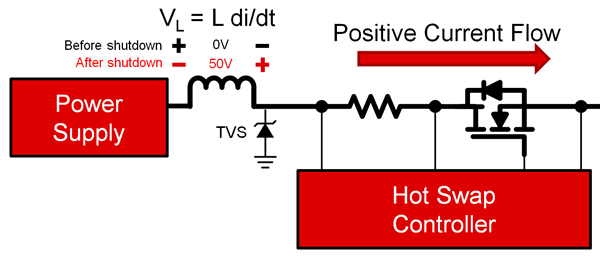Designers will often use a transient voltage suppression (TVS) diode to clamp large surge currents to a safe voltage level in order to protect nearby components from damage. In many ways, a TVS diode behaves like a Zener diode, but with a higher power-rating capability because of its larger die size and stronger wire bonding.
Why do hot-swap applications need a TVS diode?
In a hot-swap application, if there is a large overcurrent fault, then the protection integrated circuit (IC) will shut off the current quickly in order to shield nearby components from damage. This fast shutdown of current – from maybe 50 A (overcurrent) to 0 A (shutoff for protection) – can occur within tens of nanoseconds and results in a large current transient (di/dt), as shown in Equation 1:
This current will be trapped as energy inside of trace or wire inductance on the input. Although the trace inductance may be low, at a value of about 10 nH, it will still produce a surge on the input of the hot-swap controller, based on Equation 2:
That -50-V surge will be in series with the input power supply and will effectively create a positive voltage spike on the input rail, often exceeding the voltage rating of the hot-swap controller IC or metal-oxide semiconductor field-effect transistor (MOSFET) drain-to-source voltage (VDS) (see Figure 1). To prevent this voltage surge from occurring, you can place a TVS on the input to divert energy from the inductance straight to ground. The optimal placement of the TVS will be after any series inductance on the input (such as after a fuse).
Figure 1: Inductive kickback after hot-swap controller shutdown. The voltage across the inductor, VL was previously 0 V during normal operation; after fast current shutdown, VL equals 50 V and will be added in series to the input power supply
How do you choose a TVS diode?
The simplest way to pick a TVS diode for a hot-swap application is to choose one that meets the following three criteria:
- A voltage breakdown, VBR, greater than your maximum power-supply input voltage.
- A clamping voltage, VC, below the absolute maximum rating of your hot-swap controller IC or MOSFET VDS.
- A peak pulse current rating, IPP, above the peak current at which the hot-swap controller will shut off. This worst-case value is often the current visible if there is a short circuit on the output and the hot-swap controller shuts off. An accurate value to use would be the peak current measurement on an actual prototype board, with a realistic short circuit applied to the output.
For a 12-V high-power application, a common TVS choice is the 5.0SMDJ12A, which has a 5-kW transient power capability. For a deeper analysis of the equations used in choosing a TVS diode for a hot-swap application, check out the Power Electronics article, “TVS Clamping in Hot-Swap Circuits.”


